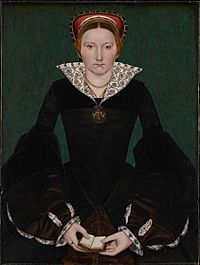Cecily Bodenham facts for kids
Quick facts for kids
Cecily Bodenham
|
|
|---|---|

Portrait alleged to be of Cecily Bodenham
|
|
| Born | before 1511 Rotherwas, Herefordshire, England
|
| Died | after 1543 |
| Title | Prioress of Kingston St Michael Abbess of Wilton Abbey |
| Parent(s) | Roger Bodenham Joane Bromwich |
Cecily Bodenham (born before 1511, died after 1543) was a very important woman in English history. She was the last "abbess" of Wilton Abbey. An abbess was the leader of a group of nuns, who were women who dedicated their lives to God. Cecily was in charge of Wilton Abbey from 1534 until 1539.
In 1539, she gave the abbey to King Henry VIII of England. This happened during a time called the Dissolution of the Monasteries. This was when King Henry VIII closed down many religious houses in England. Cecily received a good pension, which was like a regular payment, and a property in a place called Fovant. She retired there with about ten other nuns from Wilton Abbey.
Contents
Cecily's Life as a Nun
Cecily Bodenham was born in Rotherwas, Herefordshire. Her parents were Roger Bodenham and Joane Bromwich. We don't know her exact birth date.
Becoming a Prioress
Cecily became a nun at a place called Kingston St Michael in Wiltshire. She eventually became the "Prioress" there. A prioress is like a leader, but usually of a smaller religious house or a section within a larger one.
In 1511, something unusual happened. She was kidnapped by a church official from Castle Coombe. This person also stole things from the priory. Luckily, Cecily was later set free. She then went back to Kingston St Michael.
Leading Wilton Abbey
In 1534, Cecily was chosen to become the new abbess of Wilton Abbey. This was a very important position. The King's court helped her get this job. She took over from the previous abbess, Isabel Jordayne.
Cecily knew both King Henry VIII and Queen Anne Boleyn. She even paid a large sum of money, £100, to Thomas Cromwell to make sure she was chosen as abbess.
As the abbess of Wilton, Cecily was very powerful. She held a whole "barony" from the King. This meant she controlled a lot of land and had special rights. Only three other nunneries in England had this much power: Shaftesbury, Barking, and St. Mary, Winchester.
During her time as abbess, she rented out some land belonging to Wilton Abbey, called Fuggleston Manor, to a relative named Henry Bodenham.
The End of the Monasteries
Cecily followed the King's rules during the time when he was closing down monasteries. Wilton Abbey was one of the many religious houses that were closed. On March 25, 1539, Cecily willingly gave the abbey to the King's officials. She said at the time that she had "no father, brother, or assured friend" to help her.
One nun at the abbey wrote in her diary about Cecily's decision. She felt that the abbess gave up their possessions too easily. The nun also mentioned that Cecily would be rewarded with a nice house and a good income.
Cecily was indeed well rewarded. She received a generous pension of £100 every year. She also got a property in Fovant, Wiltshire. This property included an orchard, gardens, and three acres of meadow. She also received wood each year from Fovant Woods for heating. About ten of the nuns from Wilton Abbey went to live with her at the Manor Home Farm. Cecily also paid for the building of the south part of St. George's Church.
Cecily Bodenham passed away sometime after 1543. This is when her will was written.
Her Portrait
There is a portrait at the Minneapolis Institute of Art that some people believe shows Cecily Bodenham. Author Elizabeth Dorsey Hatle wrote about this in her book Portrait of a Young Woman in 2003.

